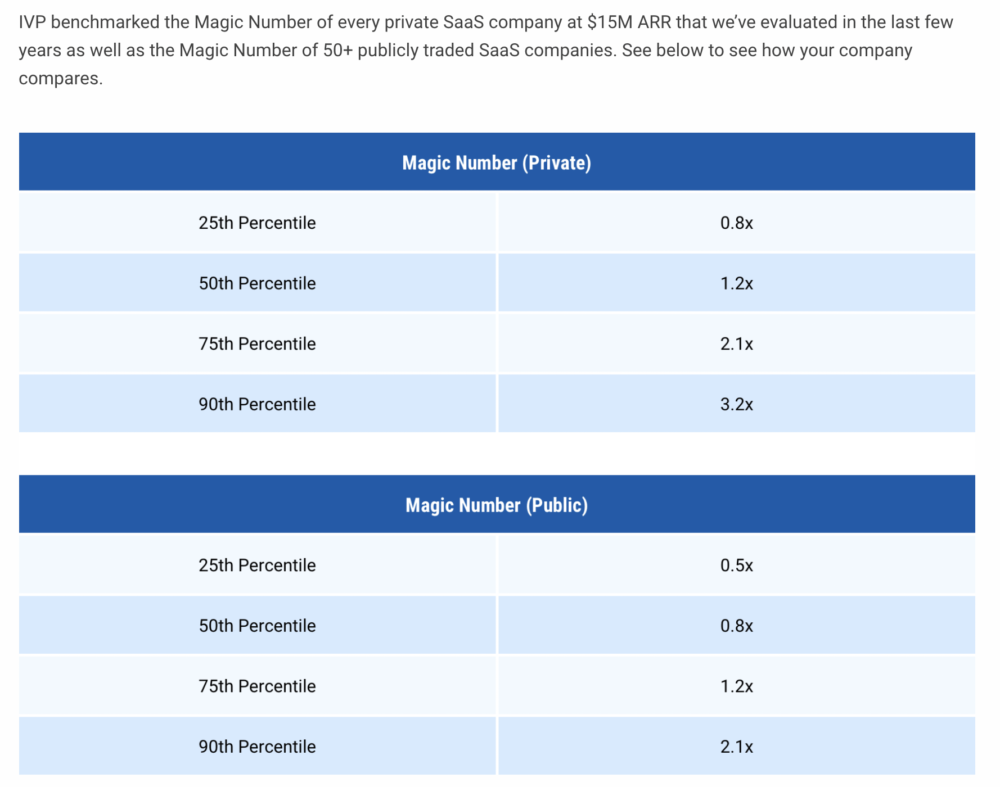The “Magic Number” is one of those metrics in SaaS that has always sort of vexxed me. On the one hand, you need a shorthand for your sales and marketing efficiency — and that’s Magic Number.
Magic Number is your growth in ARR over a quarter divided by the sales and marketing spend in the prior quarter. Generally, anything >1 is seen as healthy if you are venture-backed, and anything > 1.5 is often seen as perhaps too capital efficient. If you are well-funded, 0.75 is often seen as fine.
But there are issues with the metric:
- To even hit the 1.0 “standard” benchmark … you need capital. 1.0 in essence means you need a full year to pay back just your sales and marketing expenses for a new customer. That doesn’t even include rent, benefits, paying your engineers, etc. So anything much lower than 2 usually requires capital of some sort to fund it. And VCs are often OK with a Magic Number at low at 0.75 or so (e.g., a 16-18 month payback period) … since this is in part what the capital is for. To grow faster in general, and to expand into segments where maybe you are less competitive (and thus have to invest more in sales and marketing).
- Low Magic Numbers can be OK in the enterprise, if you are funded. But low Magic Numbers can be fatal with SMBs. It can take you 12 months to close a $1m deal. It’s OK. But for a $2k deal with 85% NRR? That’s really tough. So Magic Number calculations are absolute, but their significance is very context-sensitive.
- Including free acquisition and viral acquisition obscures underlying (in)efficiencies. Most Magic Number calculations include all customers, including ones that are acquired for free (i.e., no marketing spend) and that auto-upgrade (i.e., limited to no sales expense). That’s OK, but it can make marketing programs and sales teams look more efficient and effective than they are. The classic example is a VP of Marketing claiming tons of credit for terrible programs that don’t work where the underlying free and word-of-mouth acquisition is very strong. It can be hard to tell what’s working and what isn’t if you get full credit for the Free ones.
- Critical to adjust Magic Number for SaaS businesses with lower gross margins. This should be obvious, but it isn’t. SaaS businesses with hardware or telecom or other components that have true fixed costs need a higher Magic Number to cover those costs. I see these SaaS businesses not make adjustments for these costs, and time and time again almost run out of money even with a seemingly decent CAC and Magic Number.
- It can be gamed. As you can see above. Because it can be gamed a bit, and because even small differences can dramatically impact your burn rate, I see the #1 issue is startups burning way more than they expected even with a 1.0+ Magic Number. A 1.0+ Magic Number doesn’t mean you don’t need to carefully monitor your sales and marketing expenses.
Still, it’s a core metric. You need it to get a sense of how you are doing in SaaS, and how to plan your sales and marketing spend.
And IVP has published some data to help you benchmark it. As one of the leading later-stage B2B VC funds, IVP meets with a ton of SaaS founders at $15m+ ARR. And they’ve aggregated the data on Magic Numbers:
What’s the learning?
- The average Magic Number at $15m ARR is 1.2
- But 25% of SaaS companies hit 2.1, or go “profitable” on a customer after just 6 months
- And 10% go “profitable” on their customers in 3 months or less
So low Magic Numbers in fact aren’t that common among the winners in SaaS — the ones that get to $15m ARR, growing fairly quickly.
And a lot of them get a no-to-low cost boost from brand, viral, etc. to see a Magic Number of 2 or higher.
And finally, as you can see above, efficiency comes down post-IPO. By $200m+ ARR, you’ve often saturated core parts of your market. So sales and marketing efficiency actually goes down even as your brand becomes dominant — to an 0.8 Magic Number on average. But with lower growth expectations at scale, and the power of high NRR, it’s usually OK.
A related post here:


